Student Blog
Fieldwork

All I Do is Study for Adult Rehab ⟩
October 20, 2017, by Bryan
Classes Fieldwork Life Hacks
This semester feels like the culmination of my graduate school study skills. Speeding towards my own head-on collision with our midterm next week, I wanted to take a minute and share a few tips for getting the most out of the Adult Rehabilitation immersion course (though most of these can be applied to any course in our program).
- Talk to faculty. Whoever you receive as your instructor for the Adult Rehabilitation Immersion is a well of knowledge and wisdom. Talk to them and ask them to explain their reasoning and thought processes (i.e., ask Jane for more stories!). It is so helpful to paint a broader picture of how varied the specific injury or diagnoses might present itself in practice and the intervention/treatment ideas for each case scenario.
- Pay attention in lecture. While this sounds like common sense, lecture proved to be particularly important for me not necessarily in order to be exposed to the material for class, but to better understand how to use the information in our reading to treat patients. Building upon tip #1, the greatest thing about lecture is learning the faculty’s clinical reasoning and what observations they might expect from the patient when they hear the diagnosis of a C7 full spinal cord injury or stage 2 edema on the upper extremity. Understanding the information is just part of our job as clinicians, we must also know how to choose appropriate and attainable goals as well as treatment plan the “just right challenge” for our clients based upon a chart review and evaluation. Listening and asking the simple question, “what would you do and why would you do that?” helps prepare our own reasoning skills as students and future clinicians.
- Study consistently. I was less-than-half-probably-zero-percent-joking in my title because most of my time is actually devoted to threading through the dense material for the immersion. Amidst a jam-packed schedule, it has been an important habit to spend some time each day reviewing hip precautions and how to perform sensation testing because it takes a lot of practice and exposure to wrestle through and understand the “why” behind these procedures and information.
- Practice at fieldwork. This tip totally depends on where you are placed! I am currently at an inpatient rehabilitation unit and I have the opportunity to see most of what we talk about in class during my fieldwork day. But regardless of setting, make sure to ask questions and take initiative in practicing treatment planning and task analysis of ADLs with your CI and patients. I think something to keep in mind is to remember that you will be working with these same patients in Level 2 FW and post-graduation, so continuously be working on bedside manner and interpersonal communication.
I hope these tips help put some perspective on this immersion! Being dropped into all the information that comes with it. Study hard and enjoy the process!
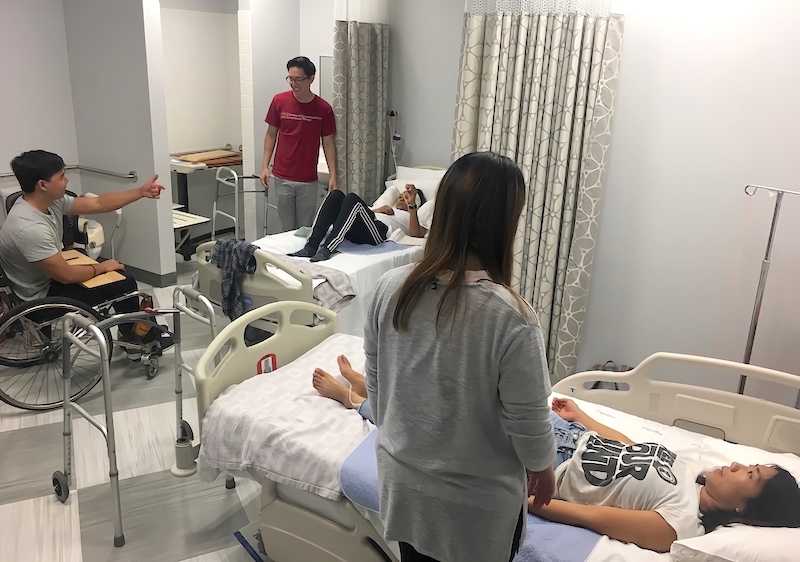
What better way to spend Thursday nights than having transfer parties?
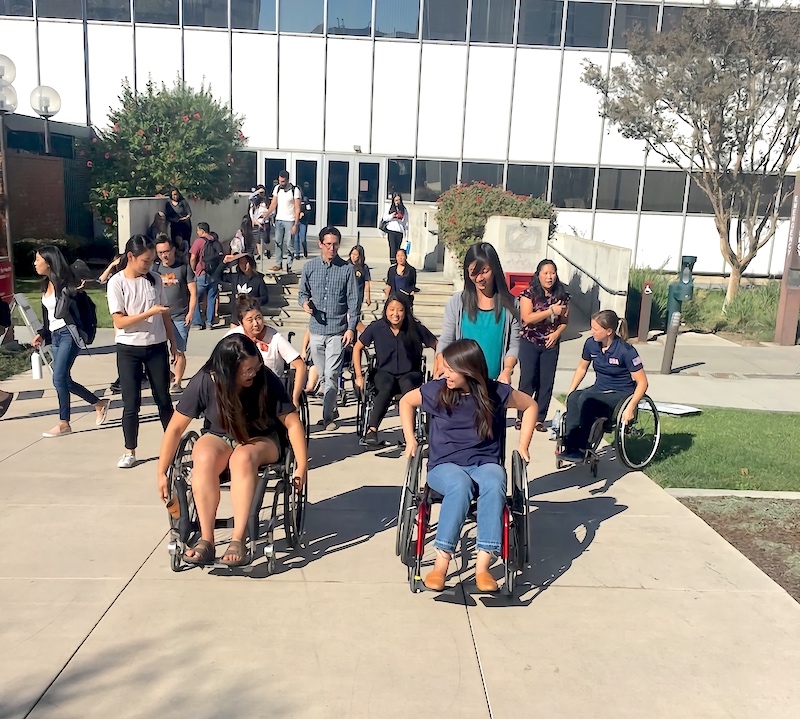
Learning how to maneuver wheelchairs!
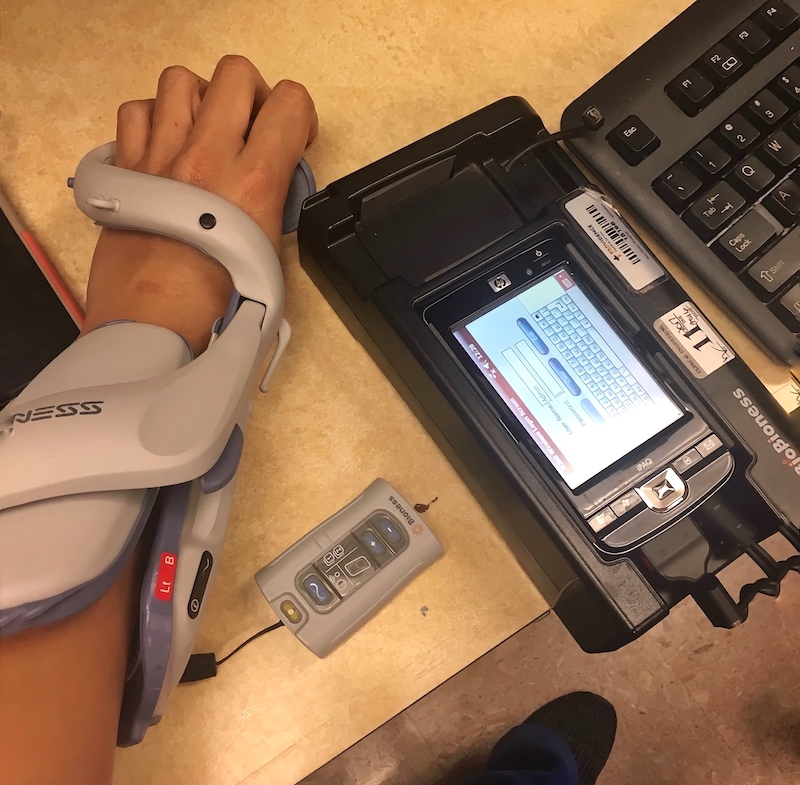
Trying out an estim at fieldwork
⋯
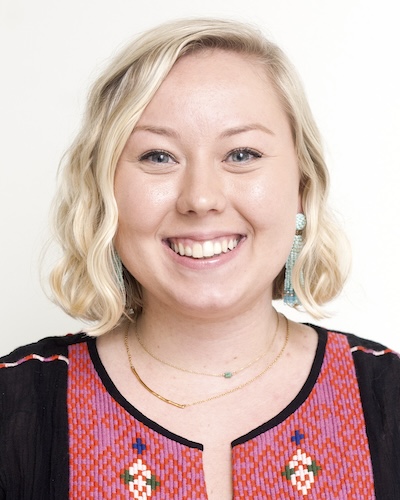
Let’s Talk Fieldwork — Part II: School-Based Pediatrics ⟩
September 28, 2017, by Caroline
Fieldwork
In my previous blog post I explained how Level I and Level II Fieldwork experiences work in our program at USC, and shared about my previous Fieldwork placements. As promised, this blog is devoted to my current Level I Fieldwork experience!
I am in the Pediatrics Immersion, which means that my Fieldwork is also in a pediatric OT setting. I’ve been placed in a local school district, so I get to see school-based pediatrics. I was really excited when I first got my placement, because I had observed pediatrics before, but not in a school-based setting, so this would be a new experience for me! I spend most of my time at an elementary school, but my Clinical Instructor (CI) and I also go over to a local high school to treat some students there as well.
I just had my 3rd day at my Fieldwork site, and I have already gotten to observe and assist with so many different things! Because my CI has a pretty consistent schedule, I get to see the same kids each week. This allows me to see growth and change in the clients, helps them to become more comfortable with me, and gives me the opportunity to begin planning and leading treatments with them as I become more familiar with them, their goals, and their interests.
The elementary school where I’m placed has a pretty unique setup, because my CI has an awesome OT clinic room all to himself — mats, obstacle course, swings, and all! With all of the materials and resources, there are so many possibilities for treatment and intervention, which is so exciting!
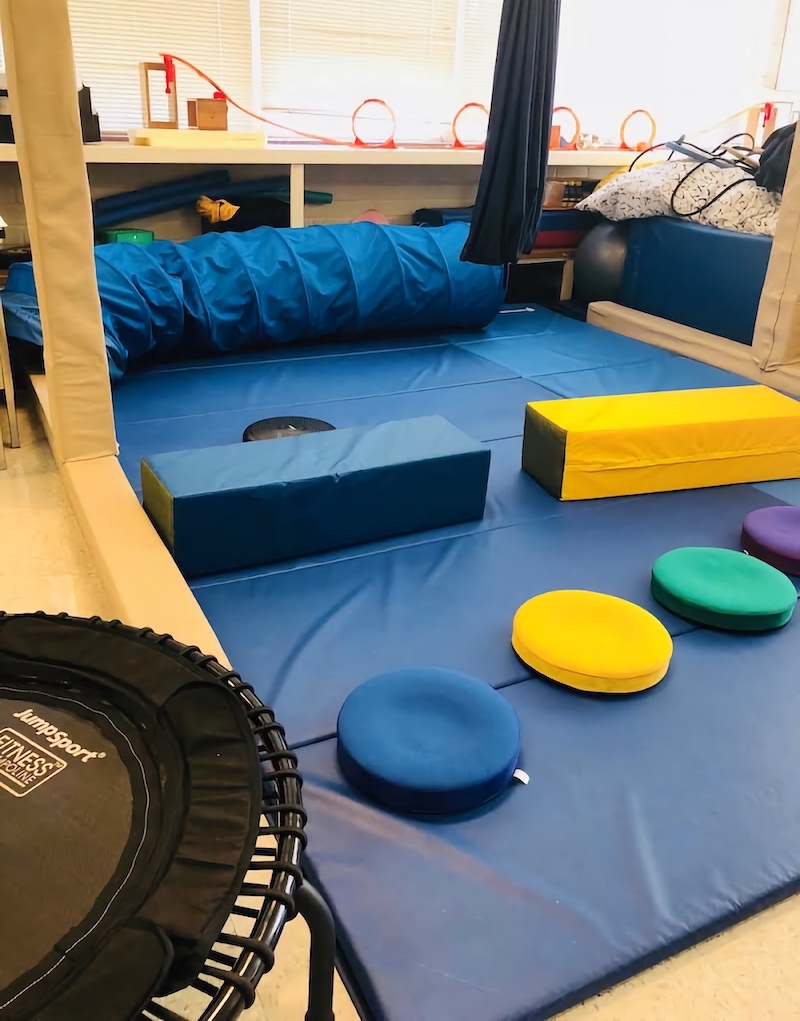
Here you can see the OT clinic space at the elementary school. Lots of space for obstacle courses, movement, and fun!
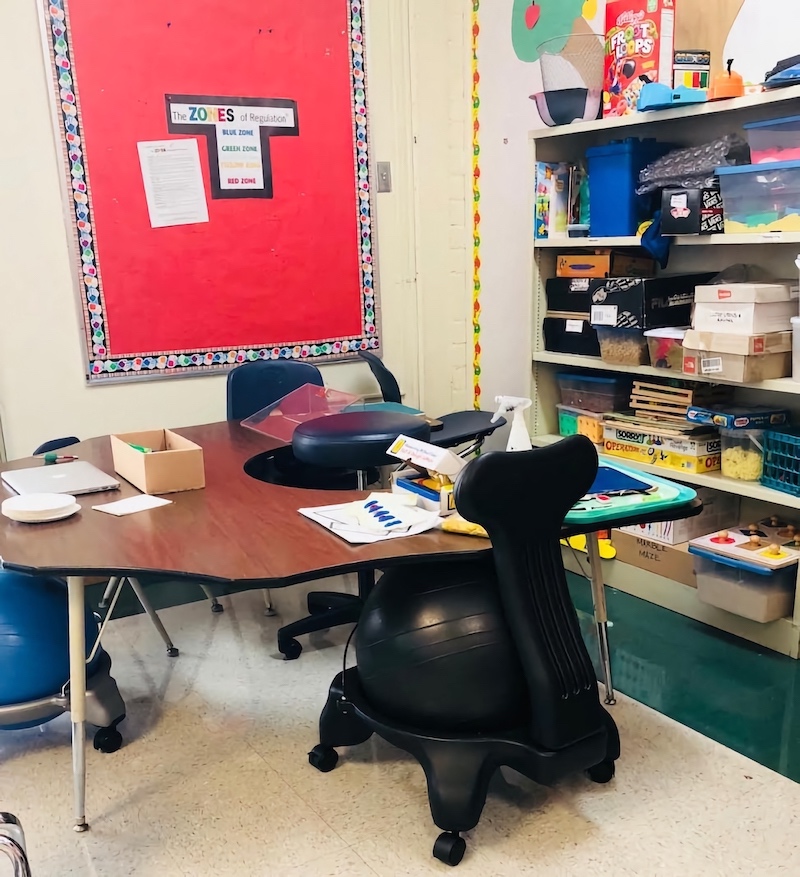
The OT clinic also has a great table-top setup to work on handwriting and other fine motor skills!
A Typical Morning at my School-Based Fieldwork Site
8:15 — Arrive, plan for the clients that day, prepare any materials needed.
9:00-9:30 — Pull a client out of class for an individual OT session. We used play-doh to work on hand strength, bilateral coordination (using both hands at the same time in a controlled manner), and pre-writing (by using the play-doh to spell out the client’s name).
9:30-10:00 — Pull another client out of class for an individual OT session. We used a three-step obstacle course in the clinic room to work on gross motor control (coordinating the large parts of your body, like legs, arms, and trunk to move) and task sequencing (progressing smoothly through a multi-step activity).
10:00-10:30 — Time for documentation and planning.
10:30-11:30 — We run an OT and Speech group with one of the Special Ed classrooms. We led the students through a song with choreographed dance moves (jumping, running in place, spinning) and then completed a craft activity based on the song that worked on fine motor skills (activities that require the use of the smaller body parts, such as the hands and fingers) like handwriting, cutting, coloring, tearing paper, and squeezing glue.
11:30-12:00 — Time for documentation and planning.
12:00-12:30 — Lunchtime (in the teacher’s lounge! It’s definitely not as mysterious as my elementary-school aged self thought it was 😊 ).
The mornings are pretty consistent, but the afternoons have a little bit more variability. Sometimes, we have meetings with parents and the rest of the team at school (Speech Therapists, Teachers, Psychologists, etc.) to address concerns or for an annual Individualized Education Program (IEP) meeting. At these meetings, it’s really cool to see the inter-disciplinary team working together to best support the individual child in the school environment. Other afternoons, we’ll go over to the nearby high school and work with some of the clients over there. I’ve enjoyed getting to see what school-based OT looks like for elementary-school aged children compared to high school students.
I’ve only had 3 days of Fieldwork, but I’m seeing individual clinic sessions with elementary and high-school aged students, group sessions, IEP and parent meetings, and more! My CI is also very open to me jumping in, taking charge, and planning and implementing some sessions with the kids. As I continue to learn more in my pediatrics class and am exposed to more at Fieldwork, I expect I’ll get more and more comfortable taking on more responsibility at Fieldwork!
My full week of fieldwork is coming up in a couple of weeks, so I’m looking forward to seeing even more clients! If you’ve observed OT in a school-based setting or have any questions about my experience, leave a comment below!
⋯

A Summer of Lessons From Master Wu ⟩
September 28, 2017, by Bryan
Fieldwork Life Hacks
I never liked kids. Maybe it was growing up as an only child, or not liking loud noises or when things get too messy (sensory sensitivities . . .), I always distanced myself from having to interact with a child more than a quick smile or wave.
With that said, this past summer I spent my 12 weeks getting to know and treating children ages 4-11 at Stepping Stones Therapy Network, a pediatrics clinic in Seattle, WA. I took advantage of the out-of-area fieldwork request and took the opportunity to work in one of my favorite cities.
While I am planning to elaborate more on the process of securing an out-of-area level 2 placement and tips throughout the process in a future post, I wanted to share a few ways in which I grew as a clinician, student, and person after completing my Level 2 FW.
- I was so prepared! I cannot stress this enough. If you put in the work throughout the semester to learn the material and listen to faculty’s tips and tricks from their own practice, you will be ready for all that comes with Level 2 FW. The hardest part about Level 2 was not the clinical reasoning needed to observe and assess a client from the multitude of OT models of practice (Sensory Integration, Biomechanical, etc.), rather the ins and outs of learning how the clinic operates and becoming more proficient with administering and scoring assessments. One of the major encouragements my clinical instructors gave me was regarding my documentation skills which I directly attributed to the fact that I was taught the OT lens in class through the case studies we discussed and from faculty’s own stories and reflections.
- The learning does not stop. Even though I had no examinations or quizzes to study for, I spent each evening looking up treatment ideas for my clients the next day, documenting on the clients I saw that day, watching YouTube videos of BOT 2 administration for my evaluation later that week, reviewing Handwriting Without Tears, all the while trying to learn the names of Ninjago characters to better connect with the kids. Fieldwork is definitely full time!
- I learned to have a BLAST on the weekends! The good thing about fieldwork is that you do not have to feel the dull (sometimes sharp) pressure of an upcoming exam that impedes your ability to just hang out and chill. I went on a lot of fun hikes and really explored Seattle which only helped me focus and perform better when I was at fieldwork during the week! I loved having a routine throughout the week: working, gym, meal prep, treatment planning, reading, and enjoying the city and friends I had during the weekends.
- Make it a priority to build a relationship with your clinical instructors and coworkers. I guess this point was easy for me this summer because I was truly blessed with amazing CIs and coworkers who were not only skilled OTs, but also mindful instructors, carefully pacing my growth as a student and clinician. I wanted to be intentional with asking them about treatment ideas and career advice moving forward. What steps should I take to go into inpatient pediatrics? What do you like about working at a peds clinic? What certifications should I pursue?

Kayaking Lake Union on Weekends

Hiked Heather Lake in June
Seattle summer weather is unreal . . .
⋯

Let’s Talk Fieldwork! ⟩
September 14, 2017, by Caroline
Fieldwork
I can hardly believe it, but this is week 4 of the fall semester, which means that all of my classmates and I are starting our Level I Fieldworks this week! In my next blog, I’ll tell you all about my first couple days of Level I Fieldwork in Pediatrics. Before I do that, I want to use this blog post to give an overview of fieldwork in general, because many prospective students have a lot of questions about it!
Fieldwork is our chance to go out into the field and see first-hand what we’re reading in our textbooks and learning about in class. In our entry-level Master’s program here at USC, we have Level I and Level II Fieldwork experiences.
Level I Fieldwork is tied in with our 3 immersion courses: Adult Physical Rehabilitation, Mental Health, and Pediatrics. Once per week, instead of going to class on campus, we report to our Fieldwork site for a full day of clinical experience. Then, in the middle of the semester, we get a week off from class and report to our fieldwork all week long. Level I Fieldwork is a great way to get exposure to a particular practice setting, make connections to what we’re learning in class, and develop some clinical and interpersonal skills!
Level II Fieldwork is a more beefed-up, immersive experience than Level I Fieldwork. While Level I Fieldwork occurs in tandem with classes during the fall and spring semesters, Level II Fieldwork is a full-time 12 week clinical experience which takes place during the second and third summers in the program. Level II Fieldwork begins with observation, but as the summer progresses, we are gradually given more responsibility, until the end of the summer, where students usually have their own caseload that they are evaluating, treating, and writing documentation about. At the end of Level II Fieldwork, the goal is to practicing at the level of an entry-level practitioner in that setting.
My first Level I Fieldwork experience last fall was during my Adult Physical Rehabilitation immersion. I was placed at St. Mary Medical Center in Long Beach. At this hospital, my Clinical Instructor (CI) and I evaluated and treated patients on the acute and ICU floors. I had never seen OT in a hospital setting, so managing IV lines, oxygen cannulas, and blood pressure monitors was totally new for me. Also new to me was working with individuals in critical conditions. I was surprised by how much I enjoyed the population and setting! I had a wonderful experience at St. Mary’s, and left feeling more comfortable working with patients in the hospital, and with a better understanding of OT’s role in an acute setting.

My Clinical Instructor had a cake decorated to celebrate my last day at St. Mary’s!
The following spring semester, my Level I Mental Health Fieldwork placement was at Gateways Forensic Community Treatment Program. This was an outpatient mental health setting that provided court-mandated services for individuals following release from prison or inpatient mental facilities. I had a lot of autonomy at this site: I got to lead groups and facilitate one-to-one OT sessions with my own caseload. Erika wrote a whole blog about embracing fieldwork sites without an OT as your CI, and I couldn’t agree with her more! I had a lot of responsibility, but I think this push was exactly what I needed to gain confidence in myself, my knowledge, and my therapeutic use of self. I was also totally unfamiliar with OT’s role in Mental Health prior to that semester, but I definitely saw the value of occupation and OT’s approach for the individuals I was working with.
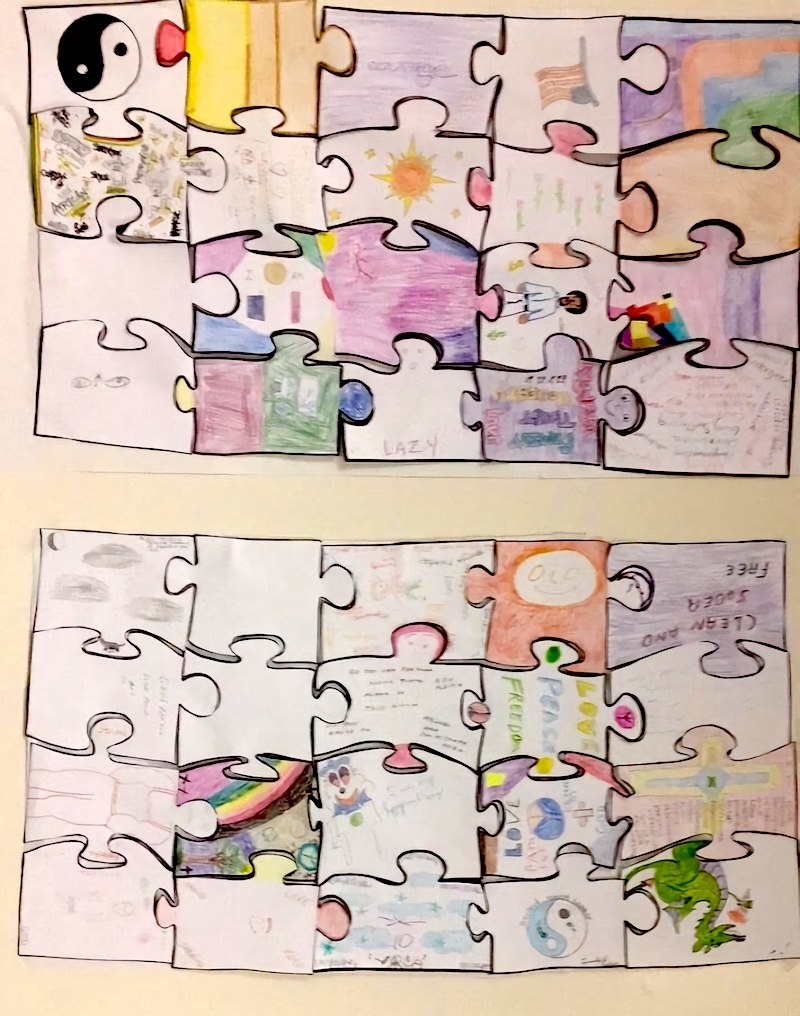
This is the final product of one of the activities I did with my group at Gateways. I asked each of the participants to create a puzzle piece that reflected their personality, how they think others saw them, and their favorite occupations. Then, the participants worked together to put together the puzzle, which ended up as a decoration on the wall in the group room!
Then came summer, where I had my first 12-week Level II Fieldwork experience. I was placed at St. Barnabas Senior Services (SBSS), a center for community-dwelling older adults. This site fell into the category of primary care and health promotion and wellness. My fellow-classmates and I were the first students to have our Level II Fieldwork at this site, so it was up to us to do a needs assessment, market our services, and establish OT’s presence at the site. While that’s hard to accomplish in the span of 12 weeks, we did establish new groups (allowing seniors to engage in new occupations), met with individual clients (that we recruited ourselves!), and led health education and literacy presentations (I provided education on fall prevention and diabetes management). A lot of things about my summer were challenging, given the nature of the site, but I definitely grew as a person and as a future OT. I enhanced my Spanish skills (75% of the time I was speaking with the older adults, it was in Spanish), learned about program development, gained familiarity with common chronic conditions commonly experienced by older adults, sharpened my clinical observation and reasoning skills, and practiced with different evaluation tools and practice models. I wasn’t sure how I felt about working with older adults at the beginning of the summer, but I could definitely see myself working with older adults in the future!
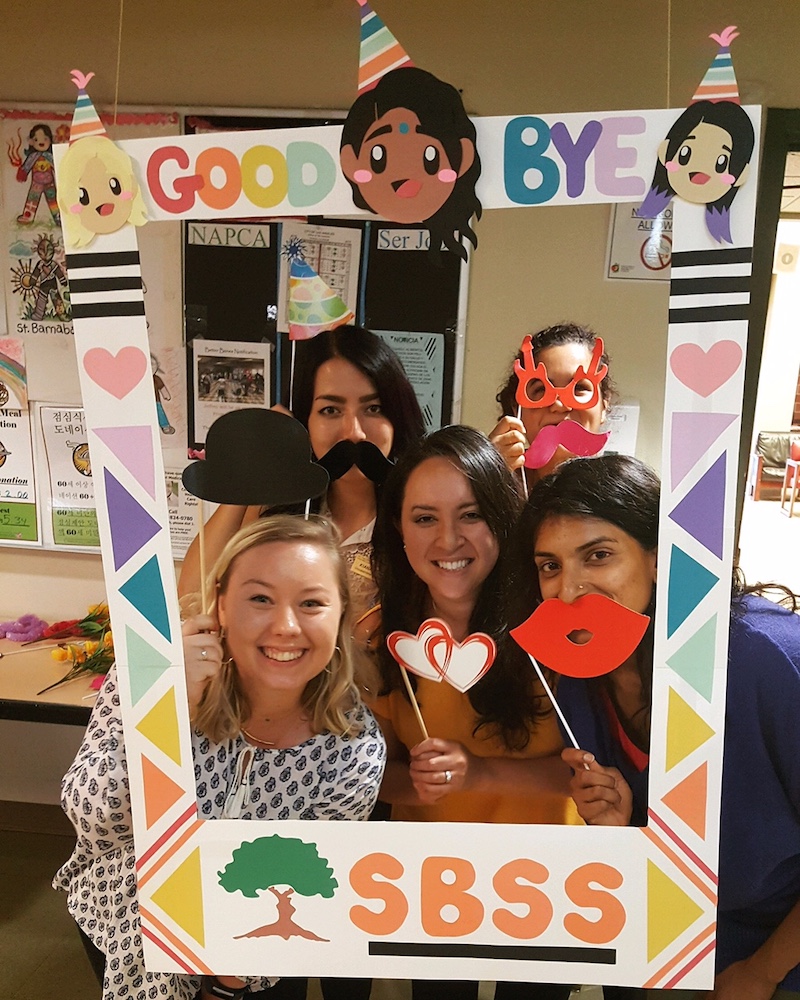
Celebrating my last day at SBSS with my fellow students, my Clinical Instructor, and my on-site supervisor!
So now I have one more Level I Fieldwork placement left, this time in Pediatrics, and then one more Level II placement next summer. As I said before, my problem (albeit a “good problem”) is that I haven’t yet found a population that I didn’t enjoy working with. I love OT because it allows me to connect with a diverse range of individuals, meet them where they are, and help them work towards getting to where they want to be. In class, we talk about how to do that, and we simulate that with case applications. Fieldwork, though, is my chance to really apply that and have a hands-on learning experience. How valuable that is!
Now that you’ve heard about my prior fieldwork experiences, stay tuned for my next blog, where I’ll tell you how my Level I pediatrics fieldwork has been going so far!
⋯
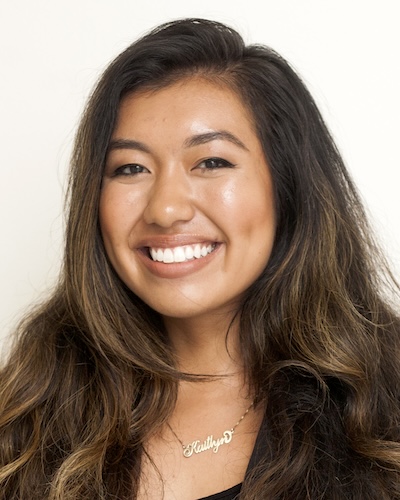
Aloha Assistance Dogs of Hawaii!: My First Level II Fieldwork Experience ⟩
September 6, 2017, by Kaitlyn
Fieldwork
Hawaii, dogs, and OT . . . if this sounds like the ultimate dream trifecta of a Level II Fieldwork then let me be the one to tell you that it is actually real (because I lived it!). This past summer, I am grateful to say that I spent 3 months in Maui with Assistance Dogs of Hawaii for my first Level II Fieldwork experience.
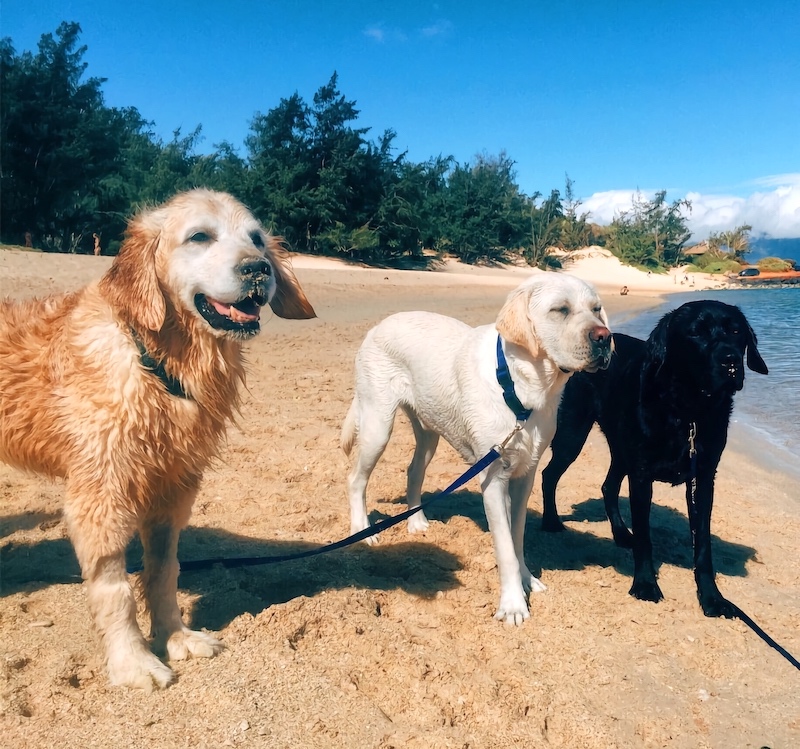
Pictured (from left to right): Ford, Wrangler, and Wesley during a trip to Spreckelsville Beach in Paia!
This journey began in March of 2017, when I first underwent an application and interview process. By the end of that month, I began to mentally prepare myself for what would be a life-changing, temporary move across the Pacific Ocean to work with one the most inspiring non-profit organizations!
Assistance Dogs of Hawaii, founded by Mo and Will Maurer, is a fully accredited, 501(c)3 non-profit organization that provides people with physical disabilities specially trained dogs to help them live more independent lives. I was lucky enough to work under the supervision of my clinical instructor, Dr. Cate Dorr, who is a certified dog trainer and occupational therapist. Between Assistance Dogs of Hawaii and working alongside Dr. Cate Dorr, I knew that it was going to be a summer full of growing and learning.
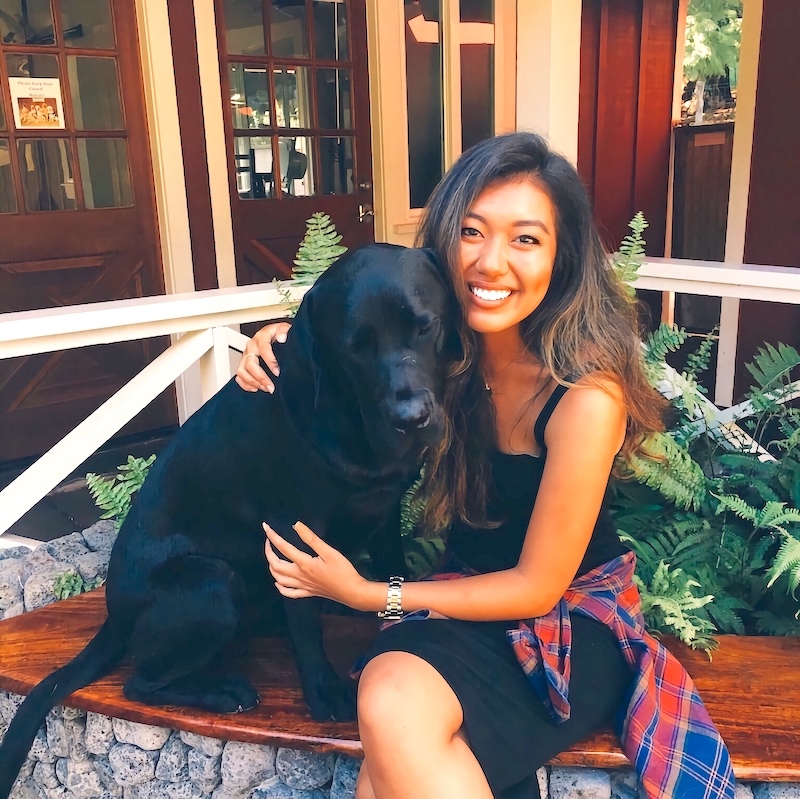
Walker (dog pictured above) weighed in at about 90 pounds! He was the biggest of the bunch with an equally big heart!
In the 3 months that I was in Maui, I was exposed to a multitude of experiences and learning opportunities. Just to name a few, I learned how to care for and train service dogs (my preview to motherhood), participated in Team Training Camp where I learned the skills of a hospital facility dog handler, conducted therapy visits, created and implemented a week-long camp dedicated to children with limited mobility called Camp Bow Wow (which was featured in Maui News!), and of course, worked with patients of all ages and diagnoses implementing occupational therapy and Canine-Facilitated Interventions (a term coined by Dr. Dorr herself!).
Towards the end of the summer, we were even provided with the opportunity to visit foundations and hospitals such as Kapiolani, Queen’s, and Shriners, all of which are located on Oahu with our (at the time) 10-week old puppies! During that same trip to Oahu, we also met with Catia Garrell, one of the founders for Thrive for Life (and an USC OT grad!) to see a home modification project in progress. At the site, we got to see how accessible home modifications are made through an OT lens, which is just another piece of evidence that since the OT scope is so broad, we should never be scared to think outside of the box!
When I wasn’t working or with the dogs, I explored the island and really immersed myself in the beauty of Hawaii (and became really tan while doing so).

On our last day of work, we spotted this huge rainbow and took it as a symbolic ‘farewell’ from Maui.
Out of all the amazing things that I got to do while I was in Hawaii, I will say that working with patients alongside my four-legged friends proved to be something that has profoundly changed my heart. For example, one of my patients broke dog treats in order to improve strength in his hands post incomplete C5-C6 spinal cord injury and another patient with spina bifida took steps alongside one of our service dogs in training to help him engage in tabletop ambulatory level activities. Seeing the motivation and intrinsic desire to do better in therapy sessions with the presence of dogs really opened my eyes to how beneficial and essential this emerging practice is to the profession of occupational therapy.
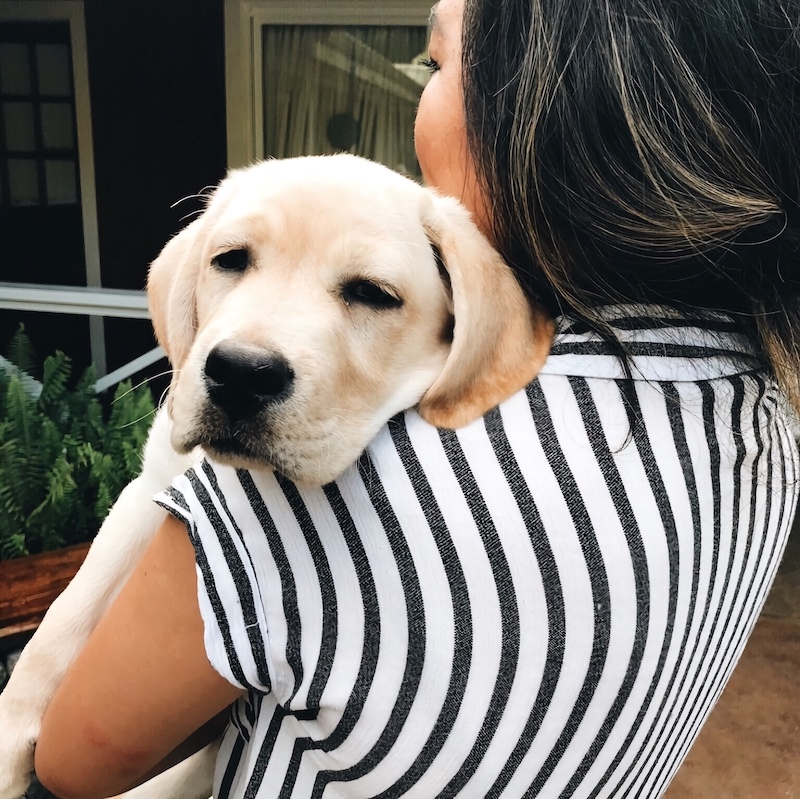
Jewel and her brother Jasper flew in to Maui at just 8 weeks old! Training began right away!
All in all, I have learned so much about dogs, occupational therapy, Canine-Facilitated Interventions, people, and myself from this Level II Fieldwork experience. Here are a few:
- Be open to every Level II Fieldwork placement possibility. Prior to receiving an offer from Assistance Dogs of Hawaii, I was looking into rehabilitation hospitals and clinics across the country, ranging from places like Nebraska to the Bay Area to New York. I knew that I wanted to expose myself to the best learning experience while being in OT school and for me that meant opening my mind to every option out there. While those did not necessarily work out for me at first, the opportunity with Assistance Dogs of Hawaii followed soon thereafter. When one door closes, it just means that there is a better door waiting for you.
- Allow yourself to make mistakes and learn from them. I am so far from perfect and I know it. The beauty of being a fieldwork student is that it is okay to make mistakes . . . so long as you learn from them and have a positive attitude about it! Your clinical instructor is there to teach and support you through these learning curves, so don’t be too hard on yourself when you don’t know everything.
- As much as you teach your patients, let your patients teach you too. I met the most inspiring individuals during my time in Hawaii and I can confidently say that I am a changed person because of them. My patients, my patients’ families and friends, and the people of Hawaii have taught me the true definitions of what it means to be resilient, compassionate, and happy. Despite any hardships they were facing during that time, they always managed to have a huge smile accompanied by a huge heart.
I’d like to end this post with one of my favorite quotes from a patient that I worked with that had ALS. During our last session together, she told me, “Kaitlyn, sometimes life will not treat you kindly. When this happens — because it will — just be strong and be kind back regardless. You will be doing amazing work as an OT, and you will change so many lives whether you know it or not.”

Mahalo Mo and Will Maurer, Dr. Cate Dorr, USC, Assistance Dogs of Hawaii, and the beautiful islands of Hawaii for the adventure of a lifetime.
⋯





